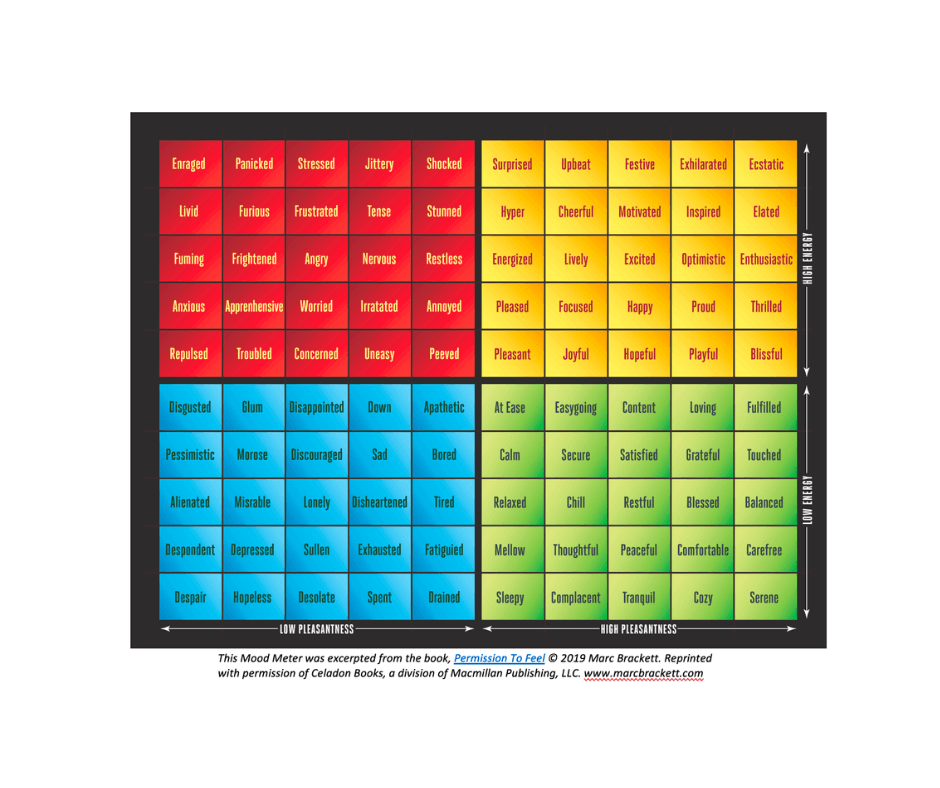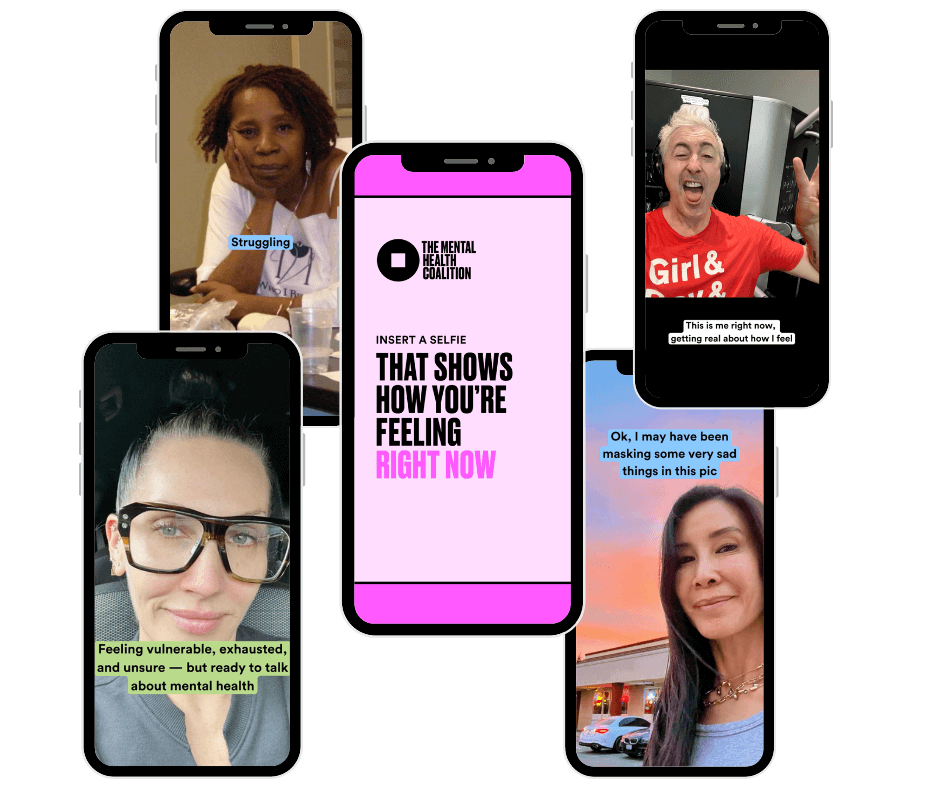If you or a friend need urgent assistance, call 911 immediately, or take your friend directly to the emergency room. If you feel it’s safe, stay with your friend, or find someone to stay with them until help arrives.
DEALING WITH FEELINGS
Emotions play a critical role in our lives by providing us with valuable information about ourselves and the world around us. They allow us to understand how we feel and what we need, guiding us in our decision-making process and influencing our behavior. By recognizing and understanding our emotions, we can learn to regulate our responses and make better decisions, leading to greater well-being and mental health.
~ Feel Your Feelings ~


The Mood Meter
The first step to dealing with your feelings? Feel them!
We like to use Dr. Marc Brackett’s system of colors and emotions, known as the Mood Meter, to help visually represent how we’re feeling. These colorful cues can help you identify how you’re feeling when you’re not quite sure.
Yellow corresponds to high-energy, high-pleasantness moods like Energized, Happy, or Optimistic. Green corresponds to low-energy, high-pleasantness moods like Content, Grateful, or Relaxed. Blue corresponds to low-energy, low-pleasantness moods like Drained, Lonely, or Sad. Finally, red corresponds to high-energy, low-pleasantness moods like Angry, Stressed, or Frustrated.
How do you feel?
Scroll through the questions below to help you determine the emotions or feelings you’re experiencing.
How pleasant or unpleasant are you feeling?
What thoughts are going through your head?
How much energy is coursing through your body?
How fast is your heart beating? What’s your breathing like?
Do you feel warm or cold? Tense or relaxed?
~ ACCEPT Your Feelings ~


Whatever you’re feeling, it’s okay to feel it. Accepting your emotions means acknowledging that your feelings are real and important, no matter what they are. It’s important to recognize that everyone experiences emotions differently, and there’s no such thing as a “right” or “wrong” feeling.
By validating your own emotions, you can start to build a stronger sense of self-awareness and self-acceptance. It also allows you to communicate more effectively with others, as you can express your feelings and needs in a healthy way. So, remember that your feelings matter and deserve to be heard, and don’t be afraid to validate yourself and others when emotions run high.
Scroll through the affirmations for different emotions below.
ANGER
I am able to weather this storm. I can find ways to express myself without losing control.
JOY
I am blissful. I follow the things that make me feel good, and nurture what feeds my soul.
LONELINESS
I am worthy of love and connection. This feeling helps me become more in touch with myself and others.
RELAXATION
I am deserving of rest. I can always find peace and calm within myself.
~ Manage Your Feelings ~


Managing your emotions means taking control of how you feel and how you react to different situations. It’s about recognizing your emotions and choosing how you want to respond to them in a healthy way.
For example, if you’re feeling angry, managing your emotions might mean taking a deep breath and stepping away from the situation before responding in a way you might regret. It’s important to learn how to regulate your emotions because it can help you feel more in control of your life and improve your relationships with others. By practicing self-regulation techniques, like deep breathing or positive self-talk, you can learn to manage your emotions in a healthy and effective way.
Below are some more techniques for managing difficult emotions.
Name the Emotion
Naming the emotion by talking about it or journaling can help you move through it by confronting it directly.
Take a Break
Taking a pause from overwhelming emotions by watching Netflix, calling a friend, or going on a walk allows you to focus on those emotions when you have more clarity.
Positive Self-Talk
Shift your internal dialogue to a tone that is more encouraging by talking to yourself like you would talk to your best friend.
Get Moving
Movement can help you increase hormones associated with emotional stability and decrease stress hormones. Any kind of movement works!
Ground Yourself
Even just 5 minutes of a meditation of grounding exercise can decrease stress and increase the mind-body connection.
Mood Tunes
Whether you want to dance around your room or need a good shower cry, music can help you manage your feelings.
In partnership with Universal Music Group, we’ve created 10 playlists for you to jam out to, available on all major music streaming platforms. Simply identify the mood that best matches how you’re feeling, and let the tunes take you away.
Check out this exclusive worksheet from Channing Shippen, Director of Music Therapy at Tufts Medical Center, to practice mood regulation through music and playlist creation.


Why Share?
Sharing your emotions is important because it helps you connect with others on a deeper level. When you express your feelings, you allow others to understand and empathize with your experiences. This creates a sense of closeness and strengthens relationships. It can be scary to open up and share your emotions, but it can also be liberating and empowering.
Additionally, sharing your emotions can help others feel comfortable sharing their own emotions with you, leading to more honest and authentic communication. So, the next time you’re feeling a strong emotion, consider sharing it with someone you trust. You might be surprised at how much closer it brings you.
Now it’s your turn!


MHC’s ‘Reveal How You Feel’ Challenge
We’ve created a simple challenge to help you share your authentic emotions on social media: The #RevealHowYouFeel Challenge.
To join in, check out our video template here, and then match the voiceover with your own photos or videos! Be sure to tag @mentalhealthcoalition on Instagram and @thementalhealthcoalition on TikTok.
RES~URCES
If you would like to learn more, be sure to check out the Mental Health Coalition’s Resource Library for additional information on boosting mental wellbeing.
If you or someone you know is experiencing a mental health crisis, use the resources below:
988
The 988 Suicide & Crisis Lifeline provides 24/7, free and confidential support for people in distress, prevention and crisis resources for you or your loved ones.
Crisis Text Line
Text COALITION to 741741 from anywhere in the United States, anytime. A live, trained Crisis Counselor receives the text and responds, helping you move from a hot moment to a cool moment.
Teen Line
Teen Line’s highly trained teen listeners provide support, resources and hope to any teen who is struggling. CALL 800-852-8336 Nationwide (6 PM – 10 PM PST).
THE EMOTIONAL PATHWAY
We’re going to walk through four key steps to navigating our emotions: feeling, accepting, managing, and sharing.
1. FEEL
Name your emotion + be curious before rushing away.
2. ACCEPT
Know that it’s okay to feel that way.
3. MANAGE
Try a coping skill to embrace or diffuse.
4. SHARE
Talk to your loved ones about how you’re doing, and check in on them, too.